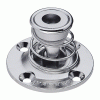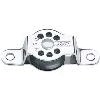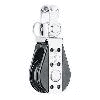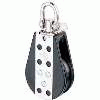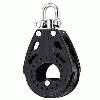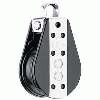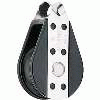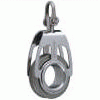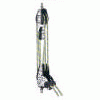For Cruising Sailors:
Trying to determine which blocks and tackle your control line system will need?
1) Review Imperial-Metric
Conversion chart below if necessary.
2) Determine the optimal block size you will need using the Block
Size Chart.
3) Determine what type of block you will need using the Block
Type Chart.
Imperial-to-Metric Conversion Chart:
| Imperial | 7/8" | 1" | 1 1/8" | 1 1/2" | 1 3/4" | 2" | 2 1/4" | 2 3/8" | 2 15/16" | 3" |
| Metric | 22mm | 25mm | 29mm | 38mm | 44mm | 51mm | 57mm | 60mm | 75mm | 76mm |
Chart to determine optimal block size for application:
| Typical Usage | Boat
Size: Small 22-28ft |
Boat
Side: Med 29-34ft |
Boat
Size: Big 35-42ft |
|||
| Minimum
Line Dia. Needed (imperial) |
Optimal Block Size* (sheave diameter) | Minimum Line Dia. Needed (imperial) | Optimal Block Size* (sheave diameter) | Minimum Line Dia. Needed (imperial) | Optimal Block Size* (sheave diameter) | |
| Traveler | 1/4 | 1-1/8" ~ 29mm | 5/16 | 1-1/2" ~ 40mm | 3/8 | 2-1/4" ~ 57mm |
| Genoa Lead Cars | 1/4 | 1-1/8" ~ 29mm | 5/16 | 1-1/2" ~ 40mm | 3/8 | 2-1/4" ~ 57mm |
| Mainsheet | 5/16 | 1-1/2" ~ 40mm | 3/8 | 2-1/4" ~ 57mm | 1/2 |
3" ~ 76mm |
| Mainsheet (Two-Speed) | 3/8 | 2-1/4" ~ 57mm | 3/8 | 2-1/4" ~ 57mm | 1/2 | 3" ~ 76mm |
| Boom Vang | 5/16 | 1-1/2" ~ 40mm | 3/8 | 2-1/4" ~ 57mm | 1/2 | 3" ~ 76mm |
| Outhaul System | 5/16 | 1-1/2" ~ 40mm | 3/8 | 2-1/4" ~ 57mm | 7/16 | 3" ~ 76mm |
| Cunningham | 3/16 | 7/8" ~ 22mm | 5/16 | 1-1/2" ~ 40mm | 3/8 | 2-1/4" ~ 57mm |
| Spinnaker Sheets | 5/16 | 2-1/4" ~ 57mm | 3/8 | 2-1/4" ~ 57mm | 1/2 | 3" ~ 76mm |
| Spinnaker Pole (Inboard End) | 1/4 | 1-1/8" ~ 29mm | 5/16 | 1-1/2" ~ 40mm | 3/8 | 2-1/4" ~ 57mm |
Spinnaker Pole (Foreguy/Downhaul) |
5/16 | 1-1/2" ~ 40mm | 3/8 | 2-1/4" ~ 57mm | 1/2 | 3" ~ 76mm |
| Backstay Adjuster | 1/4 | 1-1/8" ~ 29mm | 3/8 | 2-1/4" ~ 57mm | n/a | n/a |
| Main Halyard | 3/8 | 2-1/4" ~ 57mm | 3/8 | 2-1/4" ~ 57mm | 7/16 | 3" ~ 76mm |
| Mainsail Reefing | 5/16 | 1-1/2" ~ 40mm | 3/8 | 2-1/4" ~ 57mm | 7/16 | 3" ~ 76mm |
| Self-Tacking Jibs & Staysails | 5/16 | 1-1/2" ~ 40mm | 3/8 | 2-1/4" ~ 57mm | 1/2 | 3" ~ 76mm |
*Optimal Block Size: To reduce friction and allow line to run smoothly, we recommend using blocks designed for line diameter slightly larger (1/8") than what you will be using.
Chart to determine type of block needed:
| Type of Block | Description & Typical Usage | |
 |
Classic (with Becket) | Used for general block purposes. Becket options are used to secure a line or another block. Typical Usage: Used extensively for block and tackle systems unless specialized block is needed (such as blocks listed below). |
 |
Ratchet and Ratchamatic | Ratchet blocks allow you to hold a moderate load with little effort, as well as ease a high load with good control. The effect is analogous to a winch without a winch handle. You don't have any mechanical advantage while you're pulling in the line, but you can hold it with very little effort once it is trimmed, and ease it with good control when you want to pay out some line. In simple terms, you should use ratchets whenever you want to relieve load, so that a line can be hand-held for quick precise trimming, or when you need to deal with a high load release situation. Main use:
Mainsheet applications. Ratchamatic is Harken product; a load-sensing ratchet block that rolls freely in both directions under low loads, then automatically engages the ratchet as loads increase. Ratchet engagement can be adjusted depending on strength, sailing style and system usage. |
 |
Fiddle | Fiddle blocks build simple three and four part purchases. Their large sheave/small sheave configuration prevents line chafe and ensures a low friction tackle. Fiddle blocks come in a variety of configurations, including with hexaratchets and cam-matic cleats on adjustable arms (see below). Typical Usage:
Mainsheets, vangs, cunninghams, backstay adjusters, Three/four purchases,
outhaul systems |
 |
Fiddle with Cam (and/or Hex, and/or Becket) | Fiddles are
available with a number of options. The addition of cam allows line to be
cleated. A becket allows the end of a line to be tied off. When a hex is
engaged, the sheave will turn in only one direction. Typical Usage: Mainsheets, vangs, cunninghams, backstay adjusters, Three/four purchases |
 |
Hexaratchet | A Hexaratchet (by Harken) is a ratcheting block with a sheave that turns in only one direction when engaged. The ratcheting function on the eight-faced sheave can be turned on and off. Typical Usage: Spinnaker sheets |
 |
Micro | Micro are lightweight blocks with stainless steel sideplates. Their small size is ideal for dinghy applications or use within spars on keelboats. Generally used for line 7/32" or smaller. Typical Usage: Traveler, cunningham and outhaul control lines on dinghies; cunningham and outhaul systems on small keelboats; flag halyards, lead car retriever and leech cord on large keelboats. |
 |
Stand-up | Used when line is being redirected from a vertical plane to horizontal plane, such as a main halyard emerging from the mast, running back to a clutch. Typical Usage: Halyards, mainsail reefing, cunninghams, dedicated-winch mainsheet control, swivel-base mainsheet control. |
 |
Cheek | A classic block side-mounted, allowing line to be redirected (parallel to mounting surface). Flush with surface reduces clutter. Typical Usage: Spinnaker sheets (or use footblock), outhauls (mounted to boom for example), genoa leads, traveler, mainsheets, jib downhaul, spinnaker pole (inboard) |
 |
Thru Deck | Allows line to be transfered between mounting surface (such as outhaul system emerging from inside of boom, or tweakers mounted on outside of hull. Typical Usage: Sheets, vangs, and major control systems on dinghies or one-design keelboats; traveler controls, outhauls and tweakers on small off-shore boats; cunninghams and minor control systems on large off-shore cruisers and racers. |
 |
Upright | Transfers line on perpendicular plane, such as line emerging at the masthead. Not as suitable for walking surfaces. Typical Usage: Halyards at masthead. |
 |
Reef | Used on a boom-mounted track, creating fast and easy method of reefing the mainsail. Line is tied to steel deadend, run around bottom of boom to grommet on mailsail clew, run back down to the sheave, then run forward to block or cleat. |
 |
Wire | Can be used on split backstay systems and other wire systems. |
| Options for cutting weight, adding flexibility | ||
 |
Ti-Lite | Ultra-high strength-to-weight ratio by replacing heavy shackles. Typical Usage: Eyestrap, boom, spinnaker pole, fibreglass side tank, traveler car. Attach larger line for floating twing block. |
 |
Carbo Airblock | For high performance applications, Harken Carbo AirBlocks are 60% stronger and 30% lighter than Classic blocks. |
 |
Footblock (with or without Lock-off) | Similar to cheek block. Lock-off allows access to winch and gives flexibility to clear winch in case of override. Typical Usage: Genoa leads, spinnaker sheets |
 |
Mobile Spinnaker Jammer | Strop allows block to be placed (and moved) anywhere on deck. Full rotation ideal for spinnaker use. Can also lie flat on deck. Typical Usage: Spinnaker sheets or changing sheet winches. |
| Snatch Block | Designed for use on dinghies, dayboats and light cruising yachts where a high load capacity is not a requirement. Easy pivoting side opening action. Typical Usage: Barber hauling (moving headsail sheet forward temporarily to pull clew downward), Mast base reefing blocks, protected trip buttons, changing sheets, spinnaker sheet deflector blocks. |
|
ESP |
Elegant Simple Products | Cruising ESP is a Harken line of hardware that complements existing blocks in looks and function, but is simpler in design and construction. Ideal for cruising applications where price is more of a concern than high-end performance. |




 Proudly Canadian, est. 1999.
Proudly Canadian, est. 1999.


